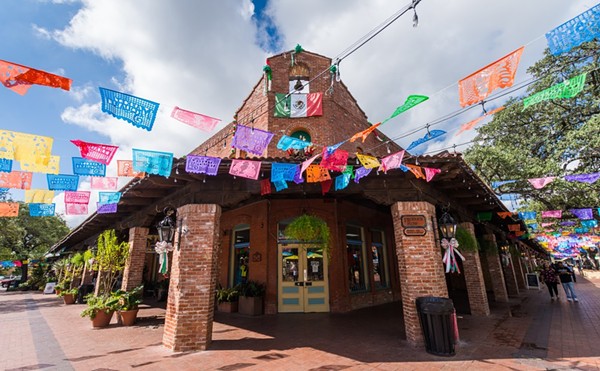Dana Clair Edwards wasn’t courting danger the night she was murdered. It was New Year’s Eve, and plenty of San Antonians were cutting loose, drinking more than usual, kissing virtual strangers in rowdy bars, seeking fresh faces to flirt with at large parties. But Edwards, a 32-year-old habitual overachiever, rang in 2009 with close friends at a small gathering that was as much family as revelry. After an evening of food and board games, they raised a glass to the new year and Dana Clair left shortly after midnight. Her best friend left at the same time, and watched Edwards embark on the mile-and-a-half drive to the small condo just north of Alamo Heights that doubled as a home office for her family’s construction business, where she lived with her dogs, Toby and Grit.
It was the last time any of Edwards’s friends saw her alive. Concerned that they hadn’t spoken with their daughter since 5:30 p.m. December 31, Darrell and Deborah Edwards went to the condo in the early morning hours of January 2. The initial police report from that night is short on details, but it’s not hard to imagine their shock and heartbreak.
“Dispatched @ 0120 HRS to the location for a daughter of the caller, stating daughter was found dead,” the officer’s notes read. The police found Dana Clair upstairs, face-down on the bathroom floor, a small pool of blood around her head, her mother kneeling next to her. “`Darrell` and his wife were asked to step out of the room and to go downstairs,” the report continues. A homicide and evidence unit were called “for a possible crime scene.”
There was ample reason to believe that’s exactly what it was. “In the room adjacent to where `Dana` was found dead were blood splattered on floor and on a rolled up carpet,” the report notes. Police would later add that there was no sign of forced entry. And although tiny Toby, a recently adopted rescue dog who remained slightly skittish, eventually emerged from his hiding place, Dana’s beloved Grit, her devoted companion for 11 years, was missing.
To date, 77 people have been murdered in San Antonio this year — most of them, if police statistics hold true, by someone they know — and the police have made 49 related arrests. But nine months after Dana Clair Edwards became the first murder victim of 2009, the investigation remains open. Another round of evidence has been sent to the crime lab; a bank surveillance camera across the street from the condo-complex entrance captured someone departing around the time of the murder, but the police have yet to name a suspect or make an arrest.
Perhaps that’s not notable in and of itself, but Dana Clair’s murder occurred within the close and cliquish circles of Alamo Heights — an incorporated township north of downtown San Antonio that prides itself on small-town ambience and a sense of elitism. The ranks of our annual Fiesta royalty are drawn reliably from the Heights and adjacent Terrell Hills and Olmos Park. Residents have been heard to call into National Public Radio shows and identify themselves as from Alamo Heights, rather than San Antonio, the metropolitan area that engulfs it. The Rose Theatre produced an original sendup of the 78209 zip code this fall, mocking a devotion to shopping and social climbing, but bumper stickers and T-shirts imperviously boast ’09 pride.
From a parents’ point of view, Dana Clair could hardly have been safer: She worked with her family and lived in a well-maintained complex in a safe part of the city. She took self-defense classes when she went away to college. “She was always very careful,” says Darrell Edwards. “She didn’t leave a door or window unlocked.” Her regular activities included walking her dogs for exercise, and keeping close friend Melissa Federspill company on Tuesday evenings while Federspill worked late at her new self-service pet salon.
If Dana Clair’s murder defies expectations, so did Dana Clair. Beautiful and brilliant, she was a class officer in high school, a Summa Cum Laude graduate of Texas Tech University, the possessor of one of those lengthy resumes stocked equally with academic achievements and social service. There are two types of people we remember from high school, says her father: the cheerleaders and the student-council presidents. Dana Clair was both. “She was 100-percent cheerleader, and 100-percent president of the student council.”
After undergrad, she attended medical school and planned to become a surgeon. She eventually worked two rounds on a transplant unit, and immediately started a campaign to sign up friends and family as organ donors. But a car accident at age 23 broke five vertebrae in her neck and caused serious spinal-cord injury, derailing her medical career. Undeterred, she returned to grad school for an MBA, and when her father was diagnosed with cancer in 2005, she returned home, where she proved an asset to the family business as an interior designer.
“Being in the home-building business with her family, she always had a set of tools,” Federspill recalls. “You would never know by looking at her how many power tools she knew how to use. On the surface, just talking with her, you wouldn’t know what a plethora of knowledge she had.
“Dana Clair would help you — with whatever you needed. If you called her, she would come.”
Another friend recalls doing just that, late on a weeknight, to borrow a staple gun so she could finish a holiday window decoration.
“I said, well you know who would have one,” the friend recalls. “Dana Clair got dressed in like 15 minutes, came over, brought the entire toolbox.”
Dana Clair’s loyalty and enthusiasm extended to the world’s orphan dogs and cats. When Fredericksburg built its first animal shelter while Dana Clair was a high-school senior, she raised money to buy dog food. More recently, she tirelessly lobbied friends to take in a stray who had been found running the streets with her new adoptee, Toby. Dana Clair had adopted Toby herself because the vet told her he had heartworms and would be the hardest to place.
But if Dana Clair was a soft touch for friends and pets in need, her personality was formidable. One friend calls her “genius intelligent,” while another describes her sense of humor as “quick-witted, with a touch of sarcasm.”
“She had a great ability to speak her mind, in a point-blank manner,” Federspill says. “She would lay it all out on the table, and you could take it or leave it. That’s just how she was.”
“If she had an opinion, you knew it,” says another friend. “She took over a room, that’s how strong she was.”
It’s possible, of course, that a strong personality might create enemies as well as friends. After her murder, an acquaintance said, “`We` talked a lot about whether `Dana Clair` could have made a contractor angry. She could piss somebody off, no doubt about it.”
Grit’s body was found at the bottom of Olmos Basin almost two weeks after Dana was murdered. The police are reluctant to reveal much about his condition, because, they say, there are details only the killer would know. From the location of his body, says Darrell Edwards, it looked as if someone pulled into the Olmos Dam turnout and threw him over the edge.
The apparent second murder of a devoted pet strikes many observers as disturbingly personal.
“I feel like Grit was a true reflection of Dana Clair (you know how sometimes they say pets become like their owners?),” wrote Federspill in an email. “He was adventurous, slightly hard-headed, he liked to chase, antagonize, and generally cause some ruckus. But he was the cutest and most loyal dog. They were very attached.”
Darrell and Deborah Edwards, dog lovers, too, say Grit could be a terror, but would have done anything he could to protect his owner. He bit a lot of people in his lifetime, says Darrell. “But no one that didn’t need to be bit.”
The case’s unresolved status has been almost unbearably hard on Dana Clair’s friends and family, but it’s also been difficult for the wider Alamo Heights community of which she was a part. If San Antonians like to joke that we enjoy only three degrees of separation from one another, in Alamo Heights it’s more like two.
On her mother’s side Dana Clair is descended from the prominent Wurzbach family, and her grandfather was noted architect Reginald H. Roberts. Her brother and mother are AH alumni, but Dana Clair was largely out of the Alamo Heights loop growing up. She attended St. Mary’s Hall, then spent two years at Alamo Heights junior and high school before finishing high school in Fredericksburg. A medical-school student who turned down a marriage proposal because, she said, the divorce rate was too high among young doctors, she was in many ways an outsider’s insider: someone who could easily slip into Heights society, but didn’t need its approval.
“Dana Clair was her own person,” Federspill says. “Like no person I’d ever met before. She was strong-willed, so intelligent, completely independent.”
When Dana Clair returned to San Antonio after her father was diagnosed with cancer, she joined one of the quintessential ’09 charitable and social clubs, the Southwest Research Institute’s Founder’s Council. There she met Thomas Ford, an Alamo Heights graduate who worked as a bookkeeper for his family’s busines, Todd-Ford Management. Although the Edwards didn’t know the Fords well before Dana Clair and Thomas began dating, mutual friends told Dana Clair’s parents that he was “one of the sweetest guys.” Dana Clair reported to her folks that “he really had nice manners, which was important to her,” says Deborah.
“We thought he was pleasant,” Deborah adds. “We didn’t think he was going to set the world on fire.”
A mutual friend describes Ford as “kind of like Drew Carey.” He often wore a bow tie, enjoyed cooking and entertaining, and attending UT football games. “I think Dana Clair thought he might have been a good match,” she said. “They were in the same social circle, he owned his own home,” and had an appealing self-deprecating sense of humor.
Dana Clair and Thomas began dating seriously, traveling together to a wedding in Colorado, and on a family trip to New Mexico, and spending holidays with each other’s family members. Among the things they had in common was a love of good food — one friend recalls a lavish picnic the pair brought to a Shakespeare in the Park production last fall when they were still dating — and a set of overlapping friendships and acquaintances that only grew closer when Dana Clair became friends with Federspill, who was dating one of Thomas’s friends. When Dana Clair ended the relationship in October 2008 after two years, she and Thomas still saw each other frequently on group social outings. Ford sent Dana Clair’s father a birthday card in late October, and the former couple reportedly had an emotional private get-together around the Christmas holiday.
But after Dana Clair’s funeral service, say friends and family, Ford essentially disappeared from their lives. Ford and his family came by the Edwards’s home after they learned of Dana Clair’s murder — Ford reportedly returned from the coast, where he had driven on January 1 — but he didn’t follow through on an offer to help make posters for Grit. The Edwards haven’t spoken with Ford or his family since.
“`Thomas` has been absent from my life since the day of Dana Clair’s service,” Federspill wrote in an email. “He’s been far from supportive. This was someone who quite regularly we did things with, and at one point in his life was very close to Dana Clair. He knew how incredibly awful this whole thing had been on me, and has never once since her service given any communication about what has been going on.”
According to friends and acquaintances, in the months following Dana Clair’s murder, Ford has spent much of his time at the coast, where his family owns vacation property. The lack of a formal suspect and his apparent absence has fueled speculation in an online public message board dedicated to Dana Clair’s memory. On April 3 one poster wrote: “As for the boyfriend not cooperating. I don’t know anything about that, although I do know him. But in these days of DNA matching, etc. surely it would be easy to confirm or eliminate him as a suspect fairly quickly. One court-ordered cheek swab and you’ve got his DNA. ... I speak from no knowledge whatsoever. It’s just frustrating.”
Later that month, someone suggested: “If I were in the middle, you are right. I would want out. But I would do it by proving my innocence. If that meant talking repeatedly with the police, I would do it. If it meant talking about it with my friends, I would do it. If it meant talking to the family of Dana, I would do it. I bet you would agree that being silent doesn’t bode well.”
Ford did, in fact, give an initial statement to investigators, but SAPD said in a meeting with the Current that he is a “person of interest,” that they have eliminated other persons of interest, and that Ford has retained a lawyer and declined to return for another interview.
“Your information is incorrect,” said Ford’s attorney, Cecil Bain. “My opinion is he has cooperated with the police.”
Rene Diaz, who represents Thomas Ford’s father, mother, and sister, but not Thomas, suggested he might sue the owners of the message board, where members have also posted comments about the family. “It’s not true of the family that they’re not cooperating,” Diaz said. “They have cooperated at every turn, with every request.”
The comments, many of which are filled with anger and accusations, are a reflection of the strain on a close-knit community that has gone months without any word of a break in the case.
“It’s frustrating for us for almost a whole year to have gone by,” says a mutual friend. “It’s hard also because it’s such an intermingled group of people.”
Darrell and Deborah Edwards say that the close social relationships in Alamo Heights have made the unresolved questions surrounding Dana Clair’s murder more painful. Darrell Edwards and Thomas’s father served on the same usher team at their church, and they move more or less in the same crowd.
“When you go to the club to eat lunch, everybody’s talking about the same thing, and everybody knows everybody,” Darrell says. “The society, as it exists in the Alamo Heights social network, it’s unbelievable that someone who is suspected wouldn’t be trying to clear their name.”
“You don’t really get to grieve while all this is going on,” says Deborah. “It’s like someone comes in and changes the dressing on your wound every day.”
Ford, who is 40 this year, may just be grieving privately, away from the Alamo Heights spotlight and painful memories. His attorney refused to let the Current speak to his client, and close friends of Ford’s declined to speak about Ford or Dana Clair’s murder. But by many accounts, he had a difficult year in 2008. His bookkeeping job in the family business reportedly evaporated when Todd-Ford, a company built by Ford’s grandfather, abruptly closed up shop. The news came as a surprise to Ford, say the Edwards, and not long after that shock, Ford’s behavior seemed to changed. While he was dating Dana Clair, he would spend weekends at the Edwards’s ranch in Fredericksburg and participate in family breakfasts and activities. But after Todd-Ford closed, they say, he began staying in bed until late in the morning, long after the rest of the household had had breakfast and headed out for the day’s
activities.
“It’s like he wasn’t participating,” Deborah said.
“He was obviously in a depressed mode,” Darrell recalled. He began to do things that were unusual for him, like leave for a day in Austin or a weekend at a mutual friend’s ranch without communicating with Dana Clair. Dana Clair worried to her parents that he wasn’t picking himself up and moving on after the collapse of the family business. She told her parents she had encouraged him to create a personal budget, and declined to do it for him when he asked. She said to her mother, “I told Thomas that `Todd-Ford` was his grandfather, and he needed to go find his own life.”
Darrell Edwards describes the young couple as “an A personality and a B personality,” yet before things began to go awry, he “thought they both thought they were going to have a life together.” But last fall, Dana Clair eventually made the decision to break up with Ford. Her close friends believed she was frustrated that the relationship wasn’t progressing toward marriage.
Dana Clair’s parents say she was conscious of the effect her decision might have on Ford, choosing a date that wasn’t too close to his October birthday or major holidays.
“Because they were in the same group of friends, Dana said the breakup had to be amicable,” her father recalled.
And by all accounts it was, at least on the
surface.
“It was a little bit awkward after the breakup,” said one friend, but Dana Clair attended Ford’s birthday party at his request, and they were together on a group trip to see Christmas lights, without incident. “So there was no question in my mind that you couldn’t have them both there.”
At the party the night she was murdered, Dana Clair played the role of judge in a word-association game called
Apples to Apples, in which the players throw down noun cards in response to adjective prompts. The judge decides whose response is the best or most entertaining. The prompt cards and their counterparts are meant to be entertaining — in response to “dysfunctional,” someone might drop a card reading “my family,” or someone might throw down “Madonna” in response to “ancient” — but the game is also designed to reveal personalities and push buttons. “Clueless,” “desperate,” or “painful” might prompt “my love life,” “bankruptcy,” or “having a baby.” And that doesn’t even encompass the heated political possibilities (Bill Clinton, Republicans, atomic bombs, Vietnam – 1968).
“ ... `Dana Clair` was in the spotlight,” Federspill recalled. “She was the center of attention, and everyone was enjoying her commentary, she was making us all laugh.”
Then Dana Clair threw out a word prompt like “useless” or “senseless,” and among the responses in the pile of replies was a card that read “marriage.” Finger-pointing and laughter ensued; some of the players demanded to know who threw down the “marriage” card. But one player, ex-boyfriend Thomas Ford, didn’t seem to find it funny. “I know that you pointed at me,” he reportedly told one participant. He didn’t appear outwardly angry, say two of the players, but when they put the game away, he got up and left without really saying his goodbyes, leaving behind the friend who rode with him.
In many ways, it was the last time they saw Thomas Ford, too. •
Dana Clair Edwards’s friends are in the process of creating a charitable foundation in her honor. “In memory of her deep and abiding love of animals, we are going to raise funds for animal shelters and for fighting violence against women,” Melissa Federspill says. “Our first fundraising event will be a 5k run /walk.” They are currently seeking sponsors. For information, please call (210) 451-0309.
Online Thursday: what we don’t know about Dana Clair Edwards’s murder, plus insight into the reporting behind the story.


















